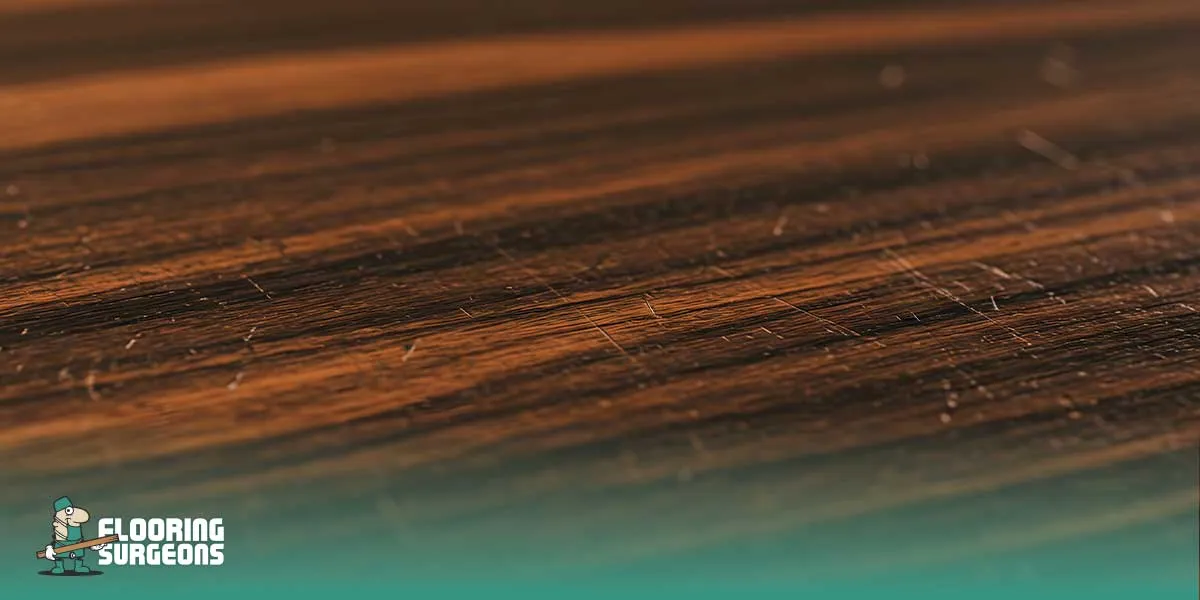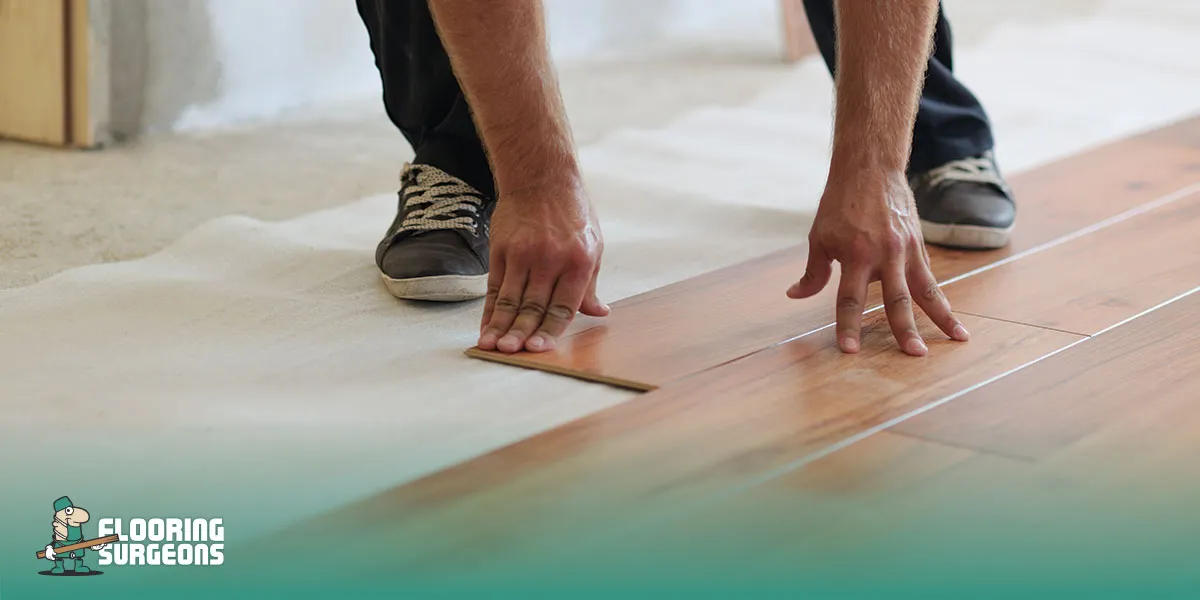Yes, laminate flooring can scratch, especially in busy homes, but the good news is that most laminate flooring scratches are completely avoidable once you understand what causes them. And that’s precisely why this topic matters: scratches often appear faster than people expect, usually right after moving furniture, getting a new pet, or even after a week of dirt being dragged in from outside.
Most homeowners who search this question aren’t just “curious”; they’re worried. Maybe they’ve just installed laminate and want to protect it. They may be considering buying laminate flooring, but aren’t sure it will look good after a year. Or maybe they’ve already spotted a few marks and want to know if this means more damage is coming. These small worries can become frustrating when you don’t know what’s normal, what’s preventable, and what’s a sign of poor-quality flooring.
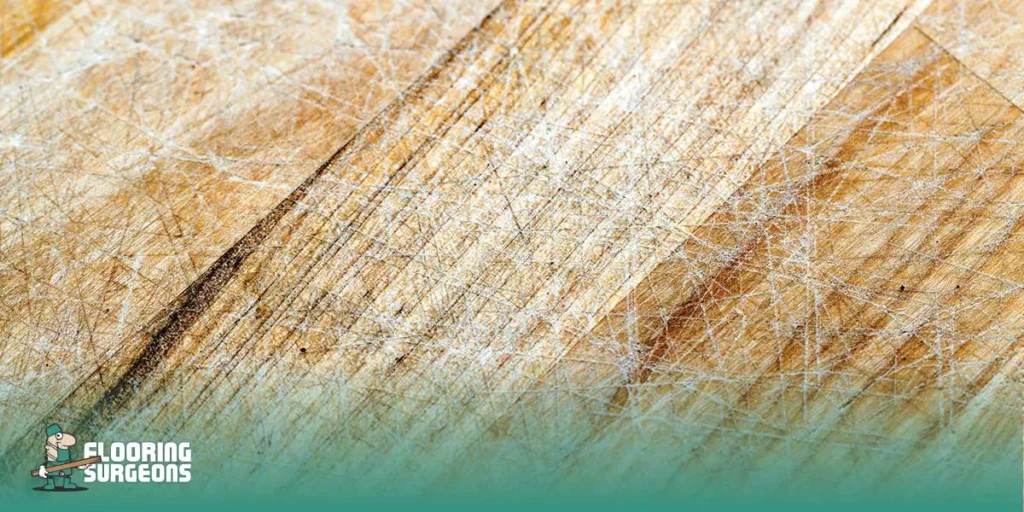
That’s why this guide goes beyond the usual generic advice. We’ll explain why laminate scratches in the first place, how to prevent everyday habits from damaging it, which types of flooring resist scratches better, and how to fix scratches if they’ve already appeared. By the end, you’ll know exactly how to keep your laminate floors looking clean, smooth, and new, without needing expensive products or complicated routines. If you want a laminate that lasts, understanding scratch prevention is step one. Let’s break it all down clearly.
How Durable Is Laminate Flooring Against Daily Scratches?
Laminate flooring is quite durable in everyday use, but it can scratch if the surface layer isn’t strong enough or if the floor is exposed to bad habits. What most homeowners in the UK don’t realise is that durability has very little to do with the core board — it all comes down to the wear layer, the clear protective topcoat that shields the design underneath. A good wear layer keeps most marks and scuffs away, while a weak one shows damage much sooner.
The interesting part is that laminate doesn’t behave like wood at all. Wood dents because it’s soft and absorbent, while laminate spreads impact across its surface, which is why it handles daily foot traffic so well. Still, even the best laminate won’t stay flawless unless the environment and maintenance match its strength. And when homeowners compare different options to decide on the best type of flooring, these subtle differences in how materials react to pressure and wear are exactly what explain why some homes keep laminate pristine for years while others start seeing scratches within months.
Why Laminate Flooring Durability Relies on the Wear Layer
The long-term durability of laminate flooring depends almost entirely on the wear layer, not the printed design or the core beneath it. A thicker, better-quality wear layer reduces laminate flooring scratches, especially from daily foot traffic, pet nails, and moving furniture.
Everyday Habits That Create Most Laminate Flooring Scratches
Major accidents don’t cause most scratches — they come from small, unnoticed habits like walking in with gritty shoes, sliding chairs without pads, or letting dust accumulate. These tiny moments create micro-abrasions that slowly wear down the surface.
How Different Quality Levels Affect Laminate Flooring Durability
Not all laminate is built equally. Budget options often have a thin wear layer that marks easily, while higher-grade laminate offers stronger protection. This is why two homes with the “same-looking” floor may have totally different experiences with scratches.
Why Some Homes Notice Laminate Flooring Scratches More Quickly
Lifestyle plays a huge role in scratch visibility. Homes with children, pets, or heavy foot traffic naturally wear more than quieter homes. Even the type of footwear used indoors can influence how fast scratches appear.
What Makes Laminate More Scratch-Resistant Than Many Expect
Although laminate flooring can scratch, it often performs better than softwood floors because it doesn’t dent easily, and the wear layer provides a more rigid surface. With simple care, laminate can stay looking fresh far longer than many people assume.
Why Laminate Floors Scratch and What Causes Surface Damage
Laminate floors scratch because tiny bits of grit, daily movement, and unprotected furniture slowly wear down the surface layer — it’s not the laminate itself, but what hits the top coating that causes the damage. Even the best scratch-resistant laminate flooring can’t stay perfect if the surface is constantly exposed to sharp pressure or rough materials.
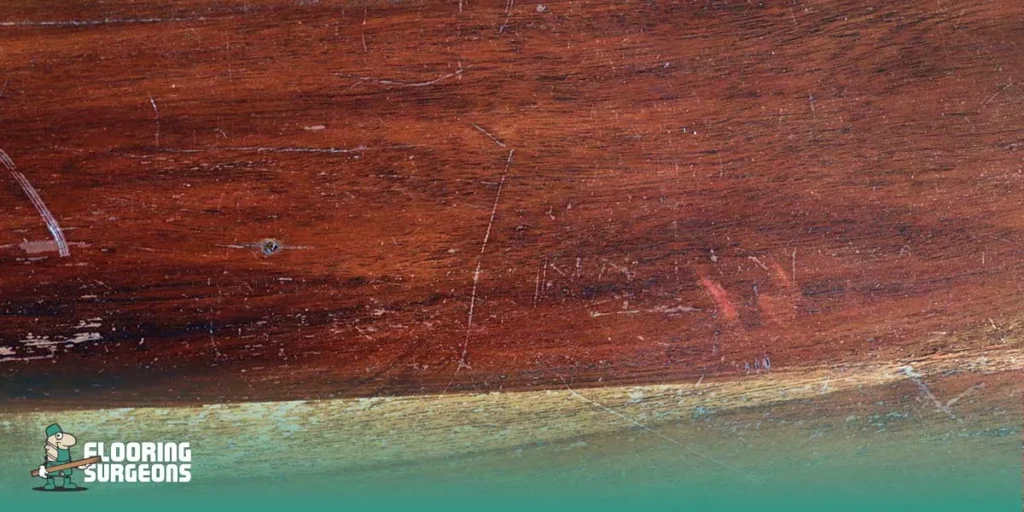
The surprising part is this: most scratches don’t happen during “big moments.” They happen quietly, in everyday life. A tiny stone stuck under a shoe, a pet turning quickly on the floor, or a chair leg dragged just once can leave a fine mark. These are microscratches you rarely notice at first, but they build up slowly and make the surface look worn. There’s another detail most homeowners never hear: laminate doesn’t like repeated friction in the same spot. A favourite chair sliding back the same few centimetres every morning, or a dog sprinting to the same doorway whenever someone knocks — these habits create slow, predictable wear. Once you understand these patterns and pair that awareness with proper care routines like those covered in how to clean laminate flooring, you can prevent the majority of scratches before they ever appear.
Homes with sunlight-heavy rooms also see scratches more clearly. The light doesn’t create scratches, but it makes the marks stand out more, especially on darker laminate. This is why some people think their flooring scratches “faster” — in reality, the scratches were always there, just not visible in dimmer rooms.
The good news? Once you know the real causes, it becomes extremely easy to learn how to prevent laminate scratches. Small changes like adding felt pads, cleaning grit before it spreads, or using small rugs in “high-friction zones” can make a bigger difference than any fancy product. Prevention is about routines, not tools. If you understand what your floor deals with every day, you can keep laminate looking new far longer than people expect — even in busy UK homes.
Practical Ways to Prevent Scratches on Laminate Flooring
The easiest way to prevent laminate scratches is to stop grit, furniture legs, and repeated friction from reaching the surface in the first place — once you block these three things, your floor instantly becomes far more durable. Most scratches happen long before you notice them, so prevention is really about small, everyday habits that protect the top layer before damage builds up. One of the most effective changes you can make is adding felt pads to anything that moves — chairs, stools, side tables, even plant stands. Most people only pad dining chairs, but the real scratches often come from smaller items you shift around without thinking. Pads cost almost nothing and instantly boost the durability of laminate flooring.
The next step is creating a “grit-free zone” at every entrance. The downside to laminate flooring is that even a single grain of sand can scrape the wear layer if you walk over it repeatedly. A simple doormat inside and outside the door can stop 80% of surface grit before it spreads across the room. If you want an extra layer of protection, a small runner near the main walkway will prevent those slow, invisible micro-scratches.

Chairs and pet activity are another hidden cause. If you’ve got a dog that sprints to the door or a cat that loves zoomies, place a small rug in their “high-speed” zones. It sounds funny, but it genuinely protects the floor because animals create more friction than shoes do. Likewise, a rolling office chair should never sit directly on laminate — a floor-safe mat instantly stops long-term wear. Keeping the floor clean also plays a huge role. You don’t need expensive cleaners, but you do need routine. A quick sweep every other day removes debris that causes the worst marks. If scratches already exist, you can remove scratches from laminate flooring with repair crayons, filler kits, or colour-matching pens — but the goal is always to stop new ones from forming.
Finally, remember this: laminate doesn’t scratch because it’s weak — it scratches because the wear layer is constantly challenged by sand, movement, and pressure. Once you control those, laminate becomes one of the easiest and lowest-maintenance floors to keep looking new.
Choosing Scratch-Resistant Laminate Flooring for Busy Homes
The best way to avoid laminate flooring scratches in a busy home is to choose scratch-resistant laminate flooring with a strong wear layer and the right AC Rating. This single choice makes a bigger difference than anything you do after installation. When people ask, “Does laminate flooring scratch easily?”, the honest answer depends almost entirely on the quality level you choose from the start.

Many UK homeowners don’t realise that laminate isn’t sold as “one standard product.” It comes in strength levels designed for different lifestyles — from quiet flats to busy, pet-filled family homes. Choosing the wrong level can cause a floor mark to wear quickly, even if you maintain it well. Choosing the right one can keep it looking new for years with minimal effort. Below is the most straightforward, easiest guide to selecting the right scratch-resistant laminate for real-life use:
Simple AC Rating Guide
| AC Rating | Where It’s Used | Scratch Protection Level | Best For |
| AC1–AC2 | Low-traffic rooms | Low | Spare rooms, occasional-use spaces |
| AC3 | Normal household use | Medium | Bedrooms, living rooms, dining areas |
| AC4 | Heavy household use | High | Homes with pets, kids, and regular foot traffic |
| AC5 | Light commercial | Very High | Hallways, busy kitchens, large families |
| AC6 | Heavy commercial | Maximum | Gyms, shops — overkill for homes |
The sweet spot for busy UK homes is AC4 or AC5. These ratings offer the strongest protection against daily friction, micro-scratches, pet claws, chairs, and grit brought in from outdoors.
What Makes One Laminate More Scratch-Resistant Than Another?
These are the fundamental factors — the ones stores rarely explain:
- The wear layer quality, not the board thickness, determines scratch protection.
- Embossed or textured finishes hide minor scratches better than glossy floors.
- Darker colours show scratches more, even on a strong floor.
- Tighter locking systems reduce edge friction — a hidden cause of scratches.
- Moisture-resistant laminates stay harder over time (dry swelling weakens durability).
Features to Look For in a Busy Household
Choose a laminate with:
- AC4/AC5 rating
- Thick wear layer (high protection)
- Matt or textured finish (more forgiving)
- Water-resistant or moisture-protected boards
- High-density core (HDF) for long-term durability
- Quality edge sealing to prevent grit from settling in joints
All these features make the floor more stable, harder, and more scratch-resistant.
What to Avoid (Mistakes That Lead to Scratches Fast)
- Choosing laminate only by colour rather than protection
- Going for glossy finishes (they show every small scratch)
- Buying low AC-rated flooring for high-traffic rooms
- Overlooking manufacturer warranties for surface wear
- Ignoring pets when choosing a floor (they’re a major scratch factor)
Quick Buying Checklist for Scratch-Resistant Laminate Flooring
- AC4 or AC5
- Strong wear layer
- Textured, matt finish
- Sealed edges
- Moisture protection
- Trusted brand with surface warranty
If all six are ticked, your laminate is ready for heavy daily life.
The Downside to Laminate Flooring: What You Need to Know Before Buying
The biggest downside to laminate flooring is that it doesn’t handle moisture or deep scratches as well as some newer flooring types, but most of these issues can be avoided if you know what to look for before buying. Laminate isn’t a “high-maintenance laminate” by nature — it’s only high-maintenance when it’s installed in the wrong room or treated like a waterproof floor, which it isn’t.

Most homeowners only hear the positives about laminate because it’s affordable and easy to install. But understanding its fundamental weaknesses helps you choose better and avoid problems later — especially if you live in a busy UK home with pets, kids, or regular foot traffic. Below is a clear, honest guide to the real-world disadvantages — explained simply, with no brand-bashing and no hidden jargon.
The Real Downsides to Laminate Flooring
| Downside | Why It Happens | What It Means for You |
| Moisture Sensitivity | Laminate’s core swells if water gets in | Not ideal for bathrooms or wet mopping |
| Deep Scratches Are Permanent | The surface layer can’t be sanded | Deep marks can’t be repaired like wood |
| Sounds Hollow Without an Underlay | Floating floors need cushioning | Good underlay is essential for comfort |
| Cheaper Ranges Wear Faster | Thin wear layer = quicker damage | Budget options may not suit busy homes |
| Edges Can Chip | High friction or impact | Needs careful moving of furniture |
| Looks Bad When Over-Cleaned | Too much water or harsh sprays | Needed: gentle, simple cleaning routine |
Moisture-Related Downsides to Laminate Flooring in UK Homes
One major downside of laminate flooring is its susceptibility to moisture. Laminate can swell, bubble, or lift if water gets into the joints — something many buyers don’t realise until it’s too late. Humid rooms, steam from dishwashers, or even wet shoes by the door can slowly weaken the boards. This doesn’t mean laminate is fragile; it just means it needs to stay dry.
Why Deep Scratches Make Laminate Feel Like a High-Maintenance Laminate
Deep marks are the one thing laminate can’t “fix”. Unlike real wood, laminate can’t be sanded or refinished, so a deep scratch is permanent. This is why some people consider it a high-maintenance laminate, but in reality, it only becomes high-maintenance if you choose the wrong AC rating or skip basic protection like felt pads and mats.
The Hidden Downsides to Laminate Flooring in High-Traffic Rooms
If you choose a thin wear layer, the floor may lose its appearance more quickly — especially in areas near sofas, dining chairs, and hallways. Cheap laminate often looks great on day one but shows wear early. This is not a “general problem with laminate” but simply a quality issue.
Why Laminate Needs Better Underlay to Avoid a Hollow Sound
Many buyers are surprised that laminate can sound hollow when walked on. That’s not a flaw — it’s because it’s a floating floor. A good underlay fixes this completely, but most people don’t realise how much a premium underlay can make until after installation.
How to Avoid the Downsides Before They Happen
- Choose AC4 or AC5 laminate for long-term durability.
- Avoid installing laminate in bathrooms, wet rooms, or laundry spaces.
- Use moisture-resistant underlay in kitchens and hallways.s
- Add felt pads under every piece of furniture — even plant pots.
- Keep a dry cleaning routine (microfibre mop, no wet mopping)
- Protect heavy-use zones with small rugs or a runner.s
- Check edge sealing — this reduces swelling and joint damage.
What Is the Most Scratch-Proof Flooring Compared to Laminate?
If your main goal is finding the most scratch-proof flooring, the top performers are SPC and high-quality LVT, with premium vinyl and engineered wood following close behind. Laminate holds up well in everyday use, but it isn’t the absolute winner when compared directly to these newer, more advanced surfaces. Still, the gap isn’t as big as most people think, and the right choice depends more on how your home is used than on the material itself.
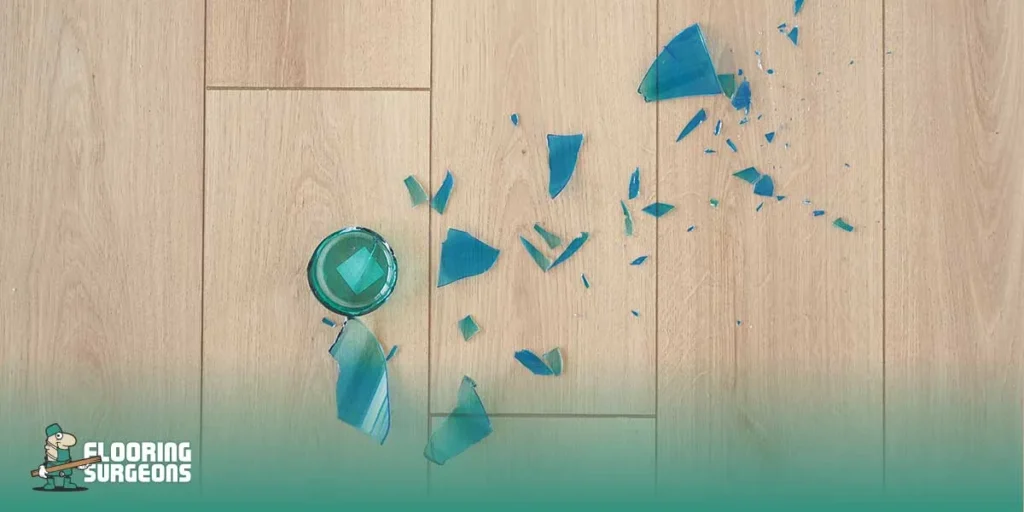
SPC tends to take the lead simply because of its stone-based core and incredibly tough top layer. It doesn’t flex, dent, or mark easily, and it holds up well to pets and constant foot traffic. For homes where chairs slide often, or children run around with toys, SPC keeps its surface looking cleaner for longer. However, the trade-off is a firmer feel underfoot, which some people find less comfortable than laminate’s warmer, more natural sensation. LVT performs differently. Instead of relying on a rigid core, it uses a flexible wear layer that absorbs light impacts rather than letting them show. That’s why it handles scuffs, pet nails and shoe marks surprisingly well. The downside for LVT is that cumbersome furniture can create dents over time — something laminate is far less prone to. While LVT can be closer to “scratch-proof flooring” in day-to-day use, it has its own limitations that homeowners should be aware of.
Vinyl sits in a similar space: strong, forgiving, and great for busy homes. It’s less likely to show fine scratches than laminate simply because the surface layer is softer. That softness, however, also means dents can occur in high-pressure spots. This doesn’t make vinyl a worse choice — it just means it protects differently. The scratch resistance is excellent, but the impact resistance varies depending on the quality. Engineered wood is the most interesting comparison. It scratches more easily than laminate because it has a real timber surface. But unlike other floors, scratches aren’t permanent. You can sand and refinish engineered wood, which gives it a long lifespan that laminate and vinyl simply don’t match. It’s not “scratch-proof flooring” in the moment, but it is the most repairable option in the long run — a strength often overlooked by buyers.
Laminate sits comfortably in the middle of all this. With the right AC rating, it can withstand daily wear and tear well enough for most households, especially in living rooms, bedrooms, and dining spaces. It isn’t the toughest flooring on the market, but it offers a balanced mix of affordability, strength, and style. In many UK homes, laminate actually performs better than expected because it doesn’t dent like vinyl and doesn’t demand refinishing like engineered wood. So, while SPC and LVT come closest to being true “scratch-proof” options, laminate remains a wise, practical choice for homeowners who want durability without the stiffness of stone-based floors or the higher cost of natural wood. The best flooring isn’t simply the most scratch-resistant — it’s the one that fits your space, lifestyle, and expectations.
Is Laminate Flooring High Maintenance or Easy to Care For?
Laminate flooring is surprisingly easy to care for, and it only becomes a “high-maintenance laminate” when it’s used in the wrong room or cleaned in the wrong way. In everyday day-to-day life, laminate needs minimal effort to stay looking good, which is why it’s still one of the most practical choices for UK homes. Most people assume laminate is delicate, but in reality, laminate flooring is highly durable as long as moisture is kept under control and the floor is protected from unnecessary friction.

The biggest downside to laminate flooring is how it reacts to water — it doesn’t handle wet mopping, steam cleaning, or spills left on the surface for too long. When homeowners forget this and treat laminate like a waterproof floor, that’s when it suddenly feels high-maintenance. But as long as you stick to dry cleaning methods and keep grit off the surface, laminate is actually one of the easiest floors to live with. Another reason it fits so well into busy homes is its resistance to dents and daily pressure — something that becomes especially important when comparing the best laminate flooring for high-traffic areas across UK households. Laminate doesn’t dent the way vinyl sometimes does and never needs refinishing like engineered wood. It’s not sold as scratch-proof, but with a proper AC rating and a few simple habits, it stays tidy and presentable with minimal effort. For most UK homes, laminate sits perfectly in that “very low effort, excellent durability” sweet spot.
How to Remove Scratches from Laminate Flooring
You can remove scratches from laminate flooring in a few simple steps, but the method depends on how deep the scratch is. Light marks are easy to fix, while deeper ones may need a repair kit. Laminate can’t be sanded like real wood, so the goal is always to blend the scratch into the surface rather than obliterate the top layer. Start by cleaning the spot to remove dust — dirt makes scratches look worse than they really are. For minor surface marks, a colour-matched laminate repair pen can mask the scratch in seconds. These pens fill the line with a shade that blends perfectly into the printed design layer. For medium scratches, a wax-based filler kit works better because it fills the groove, levels the surface, and hides the damage under a protective seal.

Deep scratches are harder to fix because they cut through the wear layer. This is where laminate flooring durability has its limit. If the mark is too large or too deep, replacing the individual board is usually the cleanest solution. Fortunately, most modern laminate floors use click-fit systems, so removing a damaged board isn’t as complicated as it seems. Fixing scratches also shows why understanding the downside to laminate flooring matters — laminate is strong against dents and daily wear, but deep cuts are permanent because it isn’t sandable. This doesn’t make the material weak; it simply works differently from engineered wood. And even though laminate isn’t sold as scratch-proof flooring, you can keep it looking good for years with the proper care. The best long-term solution is prevention: felt pads under furniture, mats at entrances, keeping grit off the floor, and choosing a high AC rating from the start. With these steps in place, you’ll rarely need scratch repairs at all.
Keeping Your Laminate Floors Scratch-Free for the Long Term
Keeping laminate floors scratch-free long-term is primarily about simple, consistent habits: stopping grit at the door, protecting high-traffic areas, and choosing the proper cleaning routine. Laminate is durable, but like any hard surface, it only stays smooth when friction and moisture are kept under control. With a few easy changes, you can reduce surface damage dramatically and keep your floor looking new for years — even in a busy UK home. The real trick is prevention: soft pads under furniture, doormats at entrances, regular sweeping to remove grit, and avoiding harsh cleaning tools. None of this is complicated, but it’s precisely the kind of practical guidance homeowners often turn to at Flooring Surgeons when they want to understand how to make laminate behave almost like scratch-proof flooring with the proper day-to-day care.



